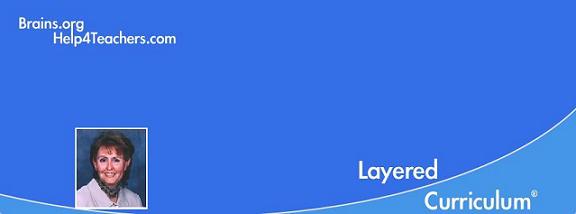__________Layered Curriculum®. . . because every child deserves a special education™_
 |
|
![]() _
_ ![]()
Layered
Curriculum TEXT & WORKBOOK
Set
for only
$43.95
(free shipping in
US)
Tweet
Attention Deficit/Hyperactivity DisorderBy Dr. Kathie F. Nunley
A student diagnosed as ADD has a neurological disability. It affects about 5% of the general population. Males outnumber females 4 to 1. There is a genetic component to ADD as it tends to run in families. However, many prenatal and postnatal factors have also been linked to ADD. All humans have an area in their brain that serves as a sensory 'filter'. This area helps filter out the important information from the unimportant so that we can focus our attention.
If you pause for a moment and concentrate on all the sensory stimuli you are receiving, you will be overwhelmed. Listen with your ears, what all can you hear? Feel with all your skin, what all can you feel? Look with your eyes, what all can you see? Imagine if all this information came into your brain with the same intensity of importance. In other words, you could not filter out the important from unimportant.
This is the ADD/HD person. The area of their brain that filters material has a chemical imbalance which limits blood flow and functioning. Many students with ADD go unrecognized in high schools because the hyperactivity component which frequently accompanies ADD in childhood, often disappears as they leave elementary school age. A hyperactive person is much easier to spot than a student with an attention deficit.
Helpful tips to include students with ADD:
*Be clear on assignments. Provide written instructions to back-up oral instructions.
*Provide clear expectations and as much routine to the class as possible.
*Use the student's name BEFORE asking a question or giving directions.
*Student-centered, or active learning is preferable to teacher-centered learning.
*Allow extra time to process information.
*Color code assignment sheets and material.
*Provide a place in the classroom for the student to leave their work and materials between classes
About the Author:
Dr Kathie Nunley is an educational psychologist, researcher and author of several books on parenting and teaching, including A Student's Brain (Brains.org) and the best selling, "Differentiating the High School Classroom" (Corwin Press). She is the developer of the Layered Curriculum® method of instruction and has worked with parents and educators around the world to better structure schools to make brain-friendly environments. In addition, her work has been used by the Boeing Corporation, Family Circle Magazine, the Washington Post, and ABC television.
Email her: Kathie (at) brains.orgCopyright © 1998 - current year by Kathie F. Nunley.
All Rights Reserved.
Layered
Curriculum is a registered trademark developed by
Dr. Kathie F. Nunley.